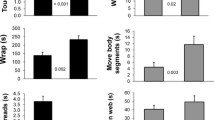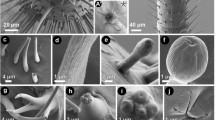Abstract
In spitting spiders Scytodes globula collected in the field, anterior leg loss was more frequent on the left than on the right side, possibly as an outcome of predatory episodes. A laboratory study was performed in which intact adult females of S. globula were placed with individuals from three species of recluse spiders, Loxosceles intermedia, L. gaucho, and L. laeta. The frequency of probing touches by spitting spiders to their prey was significantly higher with left leg I than with right leg I. Left leg II and right leg II also differed in touching frequency, but in a less marked way. The results, which may represent the first evidence of behavioral laterality in a spider species, suggest that behavioral asymmetry may be an ancient evolutionary trait.
Similar content being viewed by others
REFERENCES
Ades, C. (1995). A construção da teia geométrica enquanto instinto: primeira parte de um argumento. Psicol. USP 6: 145–172.
Babcock, L. E. (1993). Trilobite malformations and the fossil record of behavioral asymmetry. J. Paleont. 67: 217–229.
Babcock, L. E., and Robison, R. A. (1989). Preferences of paleozoic predators. Nature 337: 695–696.
Bisazza, A., Cantalupo, C., Robins, A., Rogers, L., and Vallortigara, G. (1996). Right-pawedness in toads. Nature 379: 408.
Bisazza, A., Pignatti, R., and Vallortigara, G. (1997). Laterality in detour behaviour: interspecific variation in poeciliid fish. Anim. Behav. 54: 1273–1281.
Bisazza, A., Lippolis, G., and Vallortigara, G. (2001). Lateralization of ventral fins use during object exploration in the blue gourami (Trichogaster trichopterus). Physiol. Behav. 72: 575–578. 570 Ades and Ramires
Bowden, K. (1991). The evolution of sociality in the spitting spider Scytodes fusca (Araneae, Scytodidae)—evidence from observations of intraespecific interactions. J. Zool. 223: 161–172.
Bradshaw, J. L., and Rogers, L. J. (1993). The Evolution of Lateral Asymmetries, Language, Tool Use, and Intellect, Academic Press, San Diego.
Brescovit, A. D., and Rheims, C. A. (2000). On the synanthropic species of the genus Scytodes Latreille (Araneae, Scytodidae) of Brazil, with synonymies and records of these species in other neotropical countries. Bull. Br. Arachnol. Soc. 11: 320–333.
Deckel, A.W. 1995. Laterality of aggressive responses in Anolis. J. Exp. Zool. 272: 194–200.
Eberhard, W. G. (1986). Subsocial behavior in the spitting spider Scytodes intricata (Araneae, Scytodidae). Rev. Arachnol. 7: 35–40.
Foelix. R. F. (1996). Biology of Spiders, Oxford University Press, Oxford.
Gasne, M., Millot, J. L., Brand, G., and Math, F. (2001). Intercorrelations among tests of lateralisation in the BALB/c mouse. Laterality 6: 89–96.
Govind, C. K. (1989). Asymmetry in lobster claws. Am. Sci. 77: 468–474.
Green, A. J. (1997). Asymmetrical turning during sex in the smooth newt, Triturus vulgaris. Anim. Behav. 54: 343–348.
Hamilton P. V., Nishimoto, R. T., and Halusky J. G. (1976). Cheliped laterality in Callinectes sapidus (Crustacea: Portunidae). Biol. Bull. 150: 393–401.
Hook-Costigan, M. A., and Rogers, L. J. (1996). Hand preferences in new world primates. Int. J. Comp. Psychol. 9: 173–207.
Hopkins, W. D. (1999). Heritability of hand preference in chimpanzees (Pan troglodytes): Evidence from a partial interspecies cross-fostering study. J. Comp. Psychol. 113: 307–313.
Kells, A. R., and Goulson, D. (2001). Evidence for handedness in bumble bees. J. Insect Behav. 14: 47–55.
Nentwig, W. (1985). Feeding ecology of the tropical spitting spider Scytodes longipes (Araneae, Sicariidae). Oecologia 65: 284–288.
Ottoni, E. B. (1996). Etholog 1.0: ethological transcription tool for windows. Behav. Res. Methods Instrum. Comput. 28: 472–473.
Purnell D. J., and Thompson J. N., Jr. (1973). Selection for asymmetrical bias in a behavioural character of Drosophila melanogaster. Heredity 31: 401–405.
Ramires, E. N. (1999). Uma abordagem comparativa ao comportamento defensivo, agonístico e locomotor de três espécies de aranhas do gênero Loxosceles (Sicariidae). Unpublished doctoral dissertation, Institute of Psychology, University of São Paulo, Brazil.
Rizhova, L. Y., and Vershinina, E. A. (2000). The dynamics of two different tests of laterality in rats. Laterality 5: 331–350.
Rogers, L. J. (1996). Behavioural, structural and neurochemical asymmetries in the avian brain: a model system for studying visual development and processing. Neurosci. Biobehav. Rev. 20: 487–503.
Snyder. P. J., and Bonner, J. A. (2001). Postnatal development of lateralized motor preference in the African grey parrot (Psittacus erithacus). Brain Cognit. 46: 276–279.
Udalova, G. P., and Karas, A. (1986). Asymmetry of movement direction of Myrmica rubra ants during maze learning motivated by food. Zh. Vyssh. Nervn. Deyat. Im. I. P. Pavlova 36: 707–714.
Ward, J. P., and Hopkins, W. D. (1993). Primate Laterality: Current Behavioral Evidence of Primate Asymmetries, Springer-Verlag, New York.
Warren, J. M. (1980). Handedness and laterality in humans and other animals. Physiol. Psychol. 8: 351–359.
Young, R. E., and Govind, C. K. (1983). Neural asymmetry in male fiddler crabs. Brain Res. 280: 251–262.
Author information
Authors and Affiliations
Corresponding author
Rights and permissions
About this article
Cite this article
Ades, C., Ramires, E.N. Asymmetry of Leg Use During Prey Handling in the Spider Scytodes globula (Scytodidae). Journal of Insect Behavior 15, 563–570 (2002). https://doi.org/10.1023/A:1016337418472
Issue Date:
DOI: https://doi.org/10.1023/A:1016337418472




